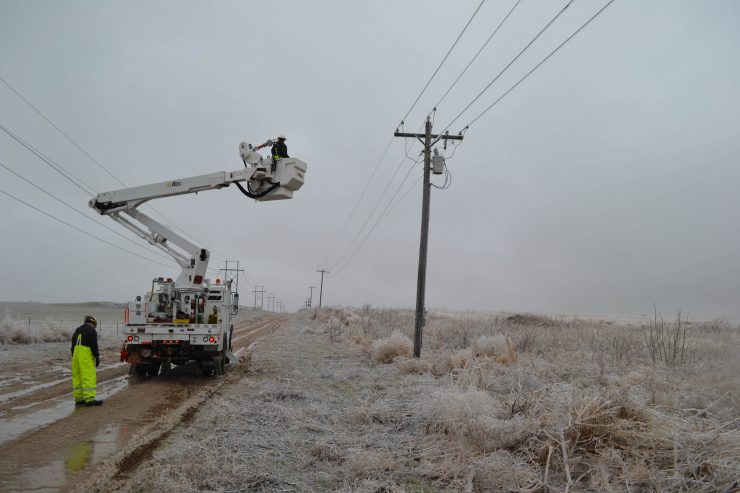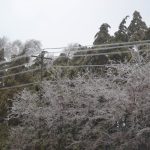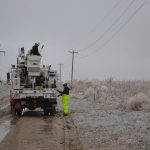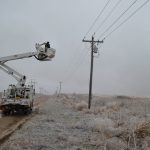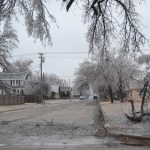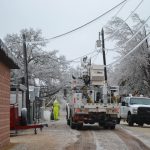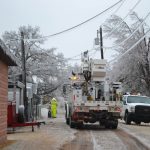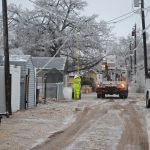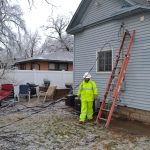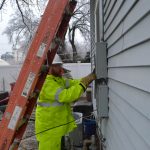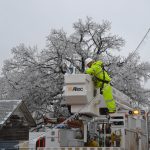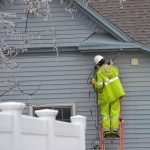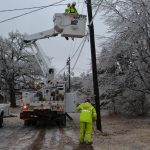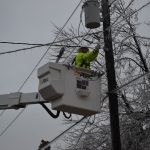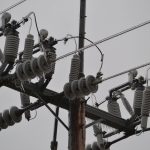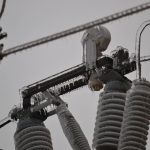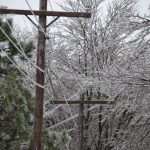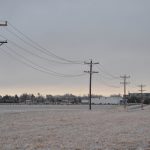
By BECKY KISER
Hays Post
The service area for Hays-based Midwest Energy covers territory from Reno County near Hutchinson, all the way northwest to the Kansas/Colorado border in Rawlins County. That’s 41 counties where MWE provides electricity and/or gas to its customers.
“And most of them have been in some kind of outage-type scenario because of the ice storm that blew through this weekend,” MWE Communications Manager Mike Morley said late Monday afternoon.
Morley and his Midwest Energy colleagues monitor the weather forecast carefully when severe weather is predicted and try to anticipate where the worst damage will be. They assign crews and hold some crews on reserve if there’s going to be a particularly bad outage.
“That’s what we did with this storm,” Morley said. “We held a couple crews back and also brought in some contract crews and had them standing by in Great Bend. So when the trouble started on Sunday afternoon, we sent the Midwest crews first. They worked into Sunday evening. And then today, Monday, it’s just gone crazy. As the ice has melted, it’s brought down lines all over the service area.
“All the Midwest crews are out. We’ve got a dozen contract crews helping us. It looks like we’re going to be working on this for several days before we’ve got the system back up to normal.”
Midwest Energy brought in contract crews from Ward Electric and PAR Electric to help repair this storm’s damage.
“They have more specialized equipment which can help put up the large transmission poles,” Morley said, “and they’re helping out in the southern part of our service area where we have several transmission lines down.”
An OMS-Outage Management System-indicates where certain circuits have opened and alerts Midwest Energy that “somewhere in this general area, there are 300 to 400 customers who are out.
“So the first thing we do is send out crews to patrol the lines, looking for obvious things like breakage on a cross-arm, maybe a tree that’s laying on some wires, or even a pole that’s broken off. Once we find that, we make the repairs as quickly as we safely can, then patrol the rest of the line and then we energize that line,” he explained.
There are 50,000 electric customers in the Midwest Energy system. As of late Monday afternoon, about 8,500 of those customers were without power.
Ice is the culprit.
An inch of ice on a power line on a 300 foot span between two poles adds about a thousand pounds of weight to that section. A pole with wires going both directions adds two thousand pounds of weight–a ton–per line on the cross arm.
“Fortunately, the cross arms are designed to stand up to a fair amount of ice,” Morley said. “Where it becomes problematic is when the wind blows. The lines begin ‘galloping,’ whipping up and down just like a jump rope. That’s what happens to the system. It basically shakes itself until it breaks.”
More problems will occur as the temperatures warm up.
“When the ice begins to melt, particularly on tiered poles where there are transmission lines on the upper part of the pole and distribution wires on the bottom, as the distribution wires melt off that weight, it’s gonna shoot up–just like a rubber band–and vibrate back and forth. As that weight comes off, the lines will snap up and hit some of the heavier lines above.
“That gives us what we call ‘blinks,’ where your lights cut in and out for just a second.”
All the utilities in Kansas sign into mutual aid, according to Morley.
